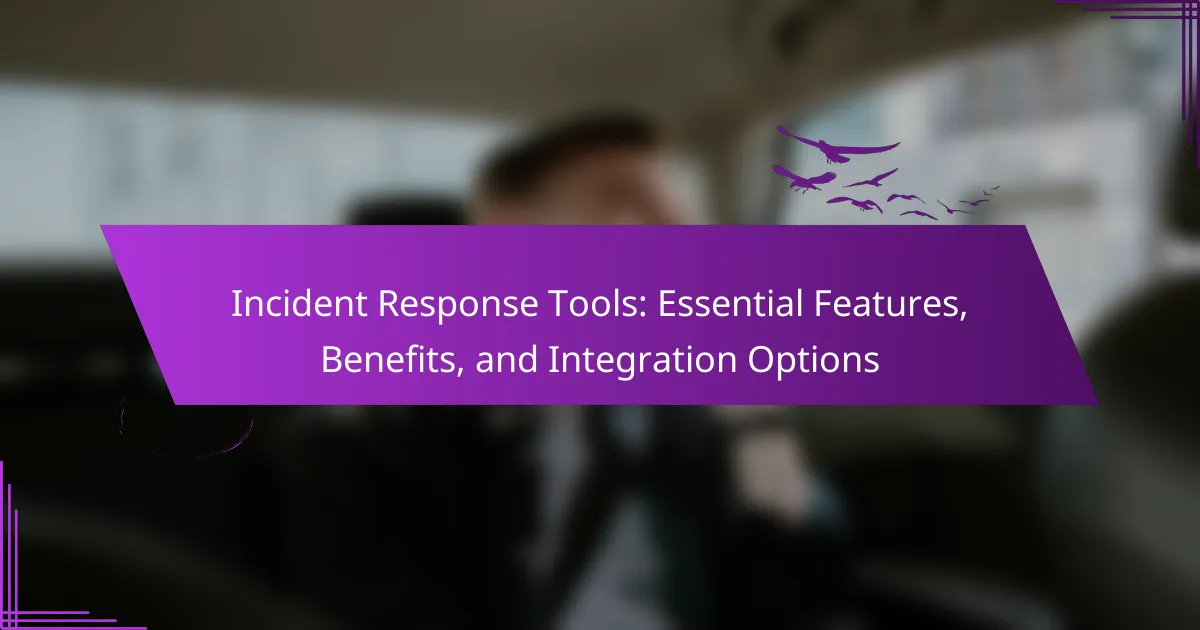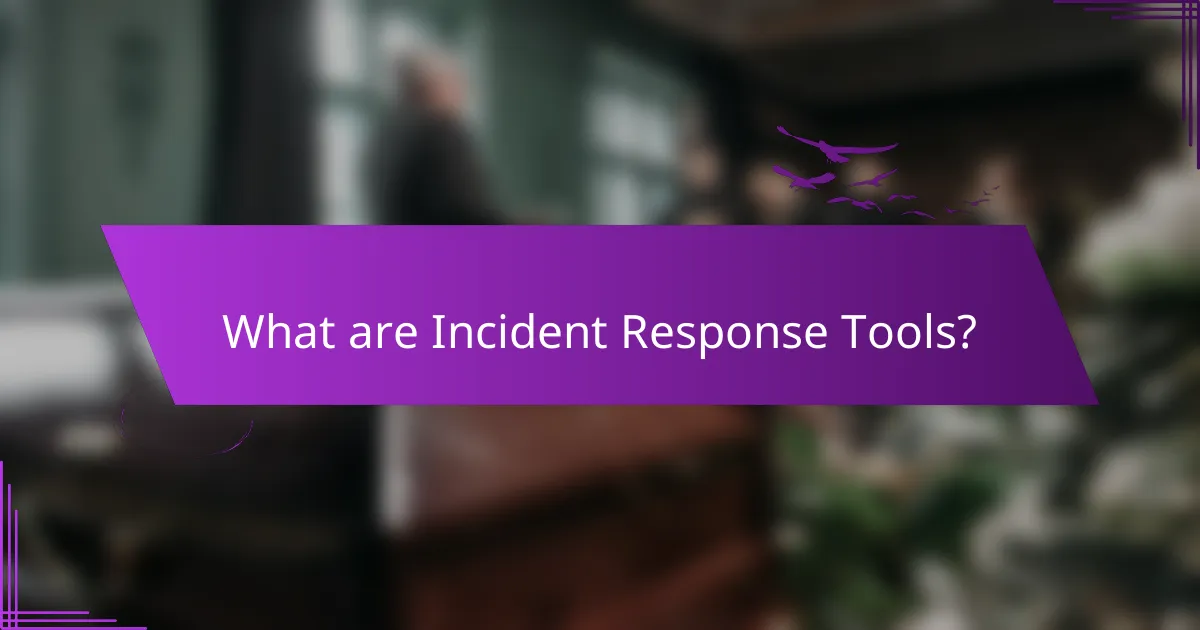
What are Incident Response Tools?
Incident response tools are software applications designed to help organizations manage and respond to cybersecurity incidents. These tools facilitate incident detection, analysis, containment, eradication, and recovery. They enable security teams to streamline processes and improve response times. Common features include automated alerts, forensic analysis, and reporting capabilities. Examples of incident response tools include SIEM software and endpoint detection solutions. Their effectiveness is demonstrated by their ability to reduce incident response times, which can significantly mitigate potential damages. Organizations often utilize these tools to comply with regulatory requirements and enhance overall security posture.
How do Incident Response Tools function in cybersecurity?
Incident response tools function by automating and streamlining the processes involved in detecting, analyzing, and responding to cybersecurity incidents. These tools enable organizations to quickly identify threats and mitigate potential damage. They often include features such as threat detection, incident analysis, and remediation guidance.
For instance, they can monitor network traffic for anomalies and alert security teams in real-time. Additionally, these tools facilitate documentation and reporting, ensuring compliance with regulations. They also integrate with other security solutions to enhance overall security posture.
According to a report by the Ponemon Institute, organizations that utilize incident response tools reduce the time to contain a breach by 27%. This statistic underscores the effectiveness of incident response tools in improving response times and reducing impact.
What are the key components of Incident Response Tools?
The key components of Incident Response Tools include detection, analysis, containment, eradication, and recovery. Detection involves identifying potential security incidents through monitoring systems. Analysis provides insights into the nature and scope of the incident. Containment focuses on limiting the impact of the incident on systems and data. Eradication aims to remove the cause of the incident from the environment. Recovery involves restoring affected systems to normal operations and ensuring that vulnerabilities are addressed. Each component is critical for an effective incident response strategy, enhancing an organization’s ability to manage security threats efficiently.
How do these components interact during an incident?
During an incident, components such as detection systems, response tools, and communication channels interact to facilitate effective incident management. Detection systems identify potential threats and alert response teams. Response tools enable teams to contain and mitigate the impact of the incident. Communication channels ensure that all stakeholders are informed and coordinated throughout the process.
For example, when a security breach is detected, the detection system triggers an alert. This alert prompts the response team to utilize their tools for containment. Meanwhile, communication channels keep relevant parties updated on the situation. This interaction streamlines the response process and enhances overall efficiency. Each component relies on the others to create a cohesive incident response strategy.
Why are Incident Response Tools essential for organizations?
Incident Response Tools are essential for organizations because they enable rapid detection and response to security incidents. These tools help minimize damage by facilitating quick identification of threats. They streamline communication and coordination during an incident, ensuring all team members are informed. Additionally, Incident Response Tools provide detailed logging and reporting capabilities. This data is crucial for post-incident analysis and improving future response strategies. According to a study by the Ponemon Institute, organizations with formal incident response capabilities reduce the average cost of a data breach by $1.23 million. Thus, these tools are vital for enhancing organizational security and resilience.
What risks do organizations face without Incident Response Tools?
Organizations face significant risks without Incident Response Tools. These risks include prolonged recovery times from security incidents. Without proper tools, organizations may struggle to identify breaches quickly. This delay can lead to increased damage and data loss. Furthermore, organizations may experience higher costs due to inefficient incident management. A lack of tools can result in non-compliance with regulatory requirements. This non-compliance can lead to legal penalties and reputational damage. Additionally, organizations may face difficulties in coordinating responses among teams. This can hinder effective communication during critical incidents. Ultimately, the absence of Incident Response Tools can severely impact an organization’s overall cybersecurity posture.
How do Incident Response Tools mitigate these risks?
Incident Response Tools mitigate risks by providing structured processes for identifying and addressing security incidents. They enable organizations to quickly detect threats through real-time monitoring and alerts. These tools facilitate rapid containment of incidents to minimize damage. They also support thorough investigation and analysis of incidents to understand their impact. Documentation features help maintain records for compliance and future reference. Additionally, they assist in communication among team members during an incident response. According to a report by the Ponemon Institute, organizations using incident response tools reduce the average cost of a data breach by 20%. This demonstrates their effectiveness in risk mitigation.
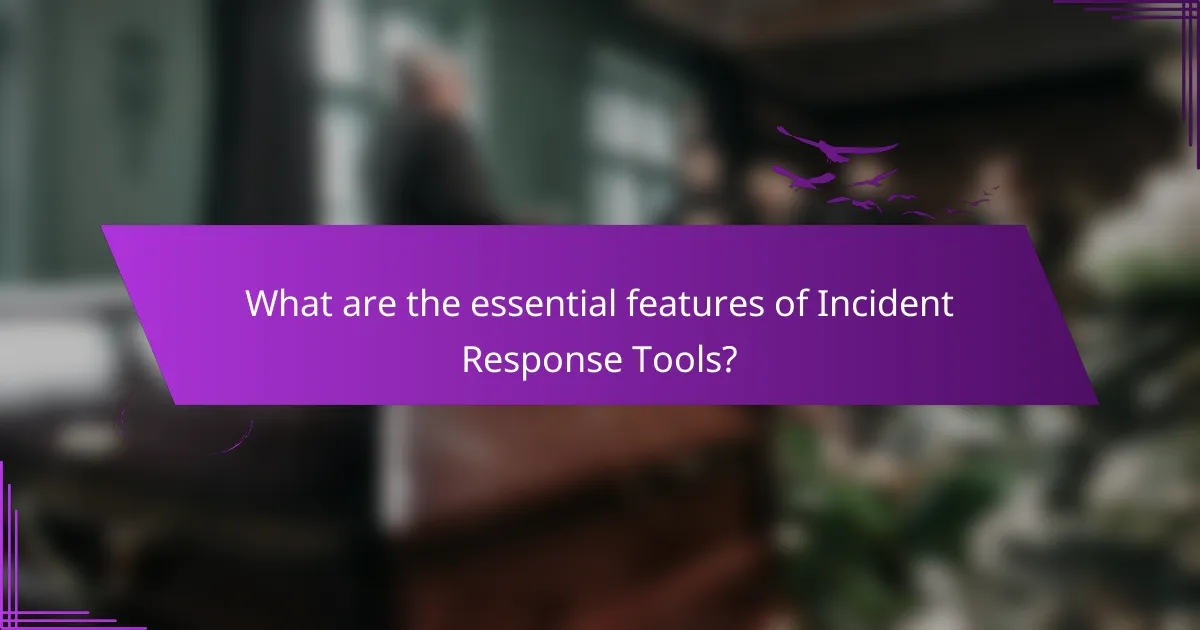
What are the essential features of Incident Response Tools?
Incident response tools are designed to facilitate the detection, management, and resolution of security incidents. Essential features include real-time monitoring capabilities for identifying threats as they occur. Automated alerting systems notify teams of potential incidents promptly. Comprehensive logging functions maintain a detailed record of events for analysis. Incident management workflows streamline the response process, ensuring efficient handling of incidents. Integration with other security solutions enhances overall effectiveness and situational awareness. Threat intelligence feeds provide contextual information about emerging threats. Reporting and analytics tools support post-incident reviews and compliance requirements. These features collectively enable organizations to respond effectively to security incidents, minimizing damage and recovery time.
What functionalities should organizations look for in Incident Response Tools?
Organizations should look for several key functionalities in Incident Response Tools. These include automated incident detection and alerting capabilities. Such features enable rapid identification of potential threats. Additionally, tools should offer incident management workflows. This functionality helps streamline the response process. Integration with existing security systems is also crucial. It ensures seamless data sharing and enhances overall security posture. Organizations should prioritize forensic analysis capabilities. This allows for in-depth investigation and understanding of incidents. Furthermore, reporting and analytics features are essential. They provide insights into incidents and inform future prevention strategies. Finally, user-friendly interfaces improve adoption and efficiency among teams.
How do automation features enhance Incident Response Tools?
Automation features enhance Incident Response Tools by streamlining repetitive tasks and improving response times. These features enable automatic detection of incidents, allowing for quicker identification of threats. Automation can also facilitate real-time data analysis, which enhances situational awareness during incidents. Furthermore, automated workflows reduce human error, leading to more consistent responses. According to a report by the Ponemon Institute, organizations using automation in incident response can reduce the time to contain a breach by up to 77%. This efficiency not only minimizes potential damage but also allows security teams to focus on strategic tasks rather than mundane operations.
What role does reporting and analytics play in these tools?
Reporting and analytics are critical components of incident response tools. They enable organizations to track and analyze security incidents effectively. These features provide real-time insights into incident trends and patterns. Reporting capabilities allow teams to generate detailed documentation of incidents. This documentation is essential for compliance and post-incident reviews. Analytics help identify vulnerabilities and areas for improvement. Through data visualization, teams can understand complex data more easily. Overall, reporting and analytics enhance decision-making and strategic planning in incident response.
How do integration options impact the effectiveness of Incident Response Tools?
Integration options significantly enhance the effectiveness of Incident Response Tools. They enable seamless data sharing between various security systems. This interconnectivity allows for faster detection and response to incidents. For example, integration with threat intelligence platforms provides real-time updates on emerging threats. Additionally, automated workflows streamline incident management processes. Research indicates that organizations with integrated systems experience 50% faster incident resolution times. Furthermore, integration facilitates better collaboration among security teams. This collaboration leads to improved situational awareness and decision-making during incidents. Overall, robust integration options are crucial for maximizing the potential of Incident Response Tools.
What systems should Incident Response Tools integrate with?
Incident Response Tools should integrate with Security Information and Event Management (SIEM) systems. SIEM systems collect and analyze security data from across an organization. This integration allows for real-time monitoring and incident detection. Additionally, Incident Response Tools should connect with threat intelligence platforms. These platforms provide up-to-date information on potential threats. Integration with endpoint detection and response (EDR) solutions is also crucial. EDR tools help in identifying and responding to threats on devices. Furthermore, integration with ticketing systems enhances incident tracking and management. This ensures a systematic approach to incident resolution. Finally, connecting with cloud security tools is important for organizations using cloud services. This comprehensive integration strategy improves overall incident response effectiveness.
How does integration improve response times and accuracy?
Integration improves response times and accuracy by streamlining communication and data sharing among incident response tools. When systems are integrated, information flows seamlessly between platforms. This reduces the time taken to gather necessary data during an incident. Consequently, response teams can act more swiftly.
Moreover, integrated tools minimize the risk of human error. By automating data transfer, the chances of miscommunication decrease significantly. Research indicates that organizations using integrated incident response tools experience a 30% reduction in response times. This efficiency leads to more accurate assessments and quicker resolutions of incidents.
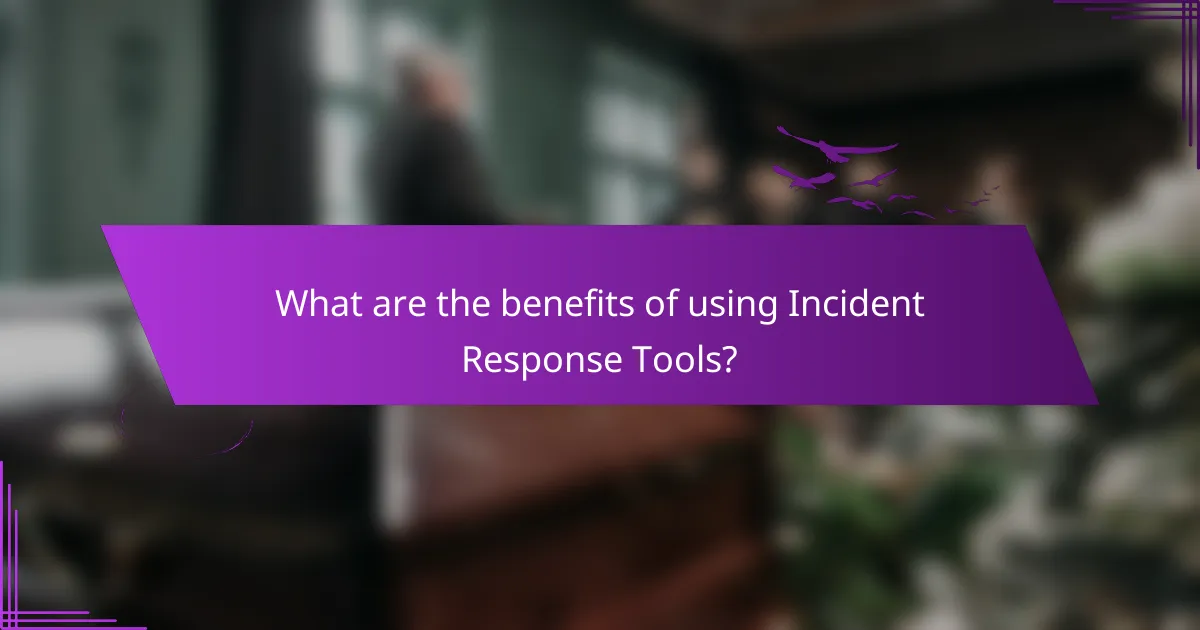
What are the benefits of using Incident Response Tools?
Incident response tools enhance the efficiency of managing security incidents. They provide automated detection and response capabilities. This reduces the time taken to identify threats. Faster response times can significantly minimize potential damage. Incident response tools also improve collaboration among team members. They centralize data and communication, streamlining the incident management process. Additionally, these tools offer detailed reporting and analytics. This helps organizations learn from incidents and strengthen future defenses. According to a study by the Ponemon Institute, organizations with incident response tools are 50% more likely to contain breaches within the first 30 days.
How do Incident Response Tools enhance incident detection and response?
Incident response tools enhance incident detection and response by automating threat identification and streamlining communication. These tools utilize real-time monitoring to detect anomalies quickly. They analyze data patterns to identify potential security incidents. Automated alerts facilitate immediate action by response teams. Integration with existing security systems improves overall situational awareness. Incident response tools also provide detailed reporting for post-incident analysis. This analysis helps organizations refine their security posture. Studies show that organizations using these tools can reduce incident response times by up to 50%.
What specific advantages do these tools provide to security teams?
Incident response tools provide security teams with enhanced detection and response capabilities. They streamline incident management processes, allowing for quicker identification of threats. These tools enable real-time monitoring of network activities. They also facilitate automated responses to common incidents, reducing manual workload. Security teams benefit from centralized logging and reporting features. This centralization aids in compliance and forensic investigations. Additionally, integration with other security solutions enhances overall security posture. Continuous updates ensure that teams are equipped to handle emerging threats effectively.
How do they contribute to overall organizational resilience?
Incident response tools enhance organizational resilience by enabling rapid recovery from incidents. They facilitate quick identification and assessment of threats. These tools streamline communication and coordination among response teams. They provide data analysis to inform decision-making during crises. Effective incident response tools minimize downtime and operational disruptions. Research indicates that organizations with robust incident response capabilities experience 50% faster recovery times. This efficiency supports business continuity and maintains stakeholder trust. Overall, incident response tools are vital for strengthening an organization’s ability to withstand and adapt to unforeseen challenges.
What industries benefit most from implementing Incident Response Tools?
The industries that benefit most from implementing Incident Response Tools include finance, healthcare, government, and retail. The finance sector requires robust incident response to protect sensitive financial data and comply with regulations. Healthcare organizations face strict privacy regulations and need to safeguard patient information from cyber threats. Government agencies must respond swiftly to potential threats to national security and public safety. Retail businesses increasingly encounter data breaches, necessitating effective incident management to protect customer information. Each of these industries experiences high stakes regarding data protection and compliance, making incident response tools essential for mitigating risks and ensuring quick recovery from incidents.
Which sectors face the highest risk of security incidents?
The sectors that face the highest risk of security incidents include healthcare, finance, and government. Healthcare organizations often handle sensitive patient data, making them prime targets for cyberattacks. According to a report by IBM, the healthcare sector experienced the highest average cost of data breaches in 2021. The finance sector is also at risk due to the valuable financial information it processes. A report from the Financial Services Information Sharing and Analysis Center (FS-ISAC) highlighted increasing cyber threats to financial institutions. Government agencies face security challenges due to the vast amounts of data they manage and the potential for politically motivated attacks. The Verizon Data Breach Investigations Report consistently shows that these sectors are among the most targeted by cybercriminals.
How do Incident Response Tools cater to the unique needs of different industries?
Incident response tools cater to the unique needs of different industries by offering tailored features and functionalities. For example, healthcare organizations require tools that comply with HIPAA regulations. These tools focus on protecting patient data and ensuring privacy. In finance, incident response tools emphasize fraud detection and regulatory compliance. They often include features that monitor transactions in real-time. The manufacturing sector may prioritize tools that address operational technology threats. These tools specifically target industrial control systems vulnerabilities. Retail industries benefit from tools that manage data breaches effectively. They focus on customer data protection and rapid incident resolution. Each industry has distinct regulatory requirements and operational challenges. Incident response tools are designed to meet these specific needs through customization and specialized capabilities.
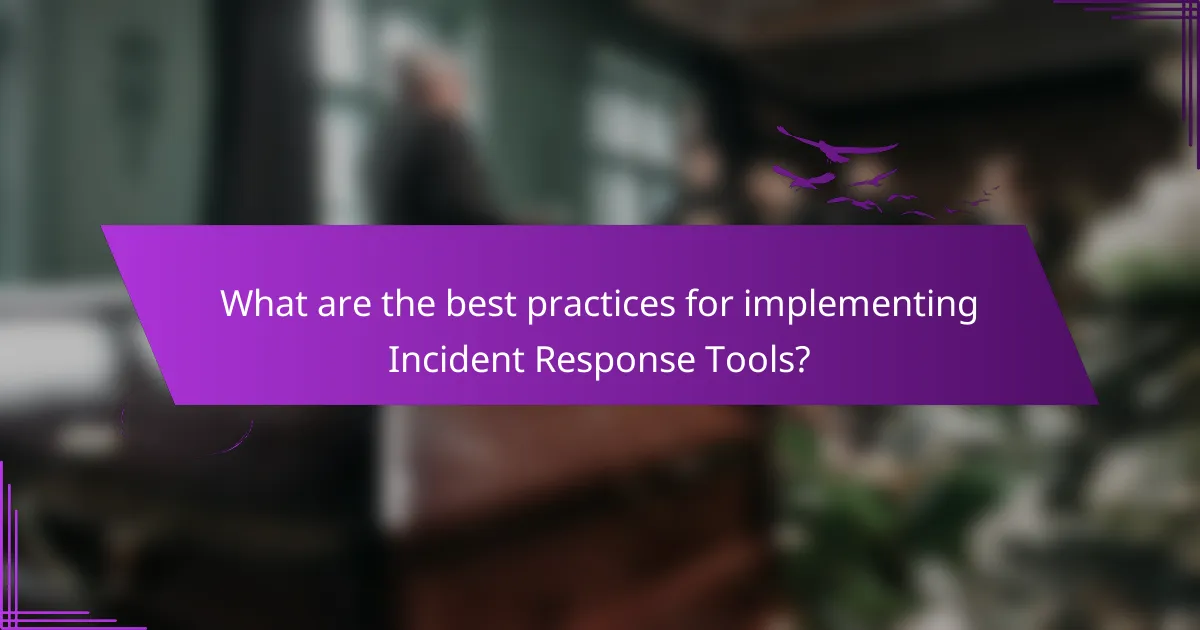
What are the best practices for implementing Incident Response Tools?
Identify clear objectives for the incident response tools. Establish what you aim to achieve with their implementation. Conduct a thorough assessment of your organization’s needs and existing infrastructure. Ensure the tools align with your specific security requirements. Develop a comprehensive incident response plan that includes the tools’ integration. This plan should detail roles, responsibilities, and procedures for effective use. Regularly train your team on the tools and incident response processes. Continuous training enhances readiness and effectiveness during incidents. Evaluate the tools’ performance regularly to ensure they meet operational goals. Update the tools and processes based on feedback and evolving threats. Engage in regular simulations to test the incident response capabilities. Simulations help identify gaps and improve response strategies.
How can organizations effectively choose the right Incident Response Tools?
Organizations can effectively choose the right Incident Response Tools by assessing their specific needs and requirements. First, they should evaluate the types of incidents they are likely to encounter. This includes understanding their threat landscape and identifying potential vulnerabilities. Next, organizations must consider the scalability of the tools. Tools should be able to grow with the organization’s needs. Additionally, integration capabilities with existing systems are crucial. Tools must work seamlessly with current security infrastructure.
Moreover, organizations should look for user-friendliness. Complex tools can hinder effective incident response. They should also prioritize tools with strong vendor support and documentation. This ensures quick resolution of any issues that arise. Finally, organizations should conduct trials or demos of the tools. This allows them to assess functionality and ease of use in real-world scenarios.
What criteria should be used for evaluating different tools?
Criteria for evaluating different tools include functionality, usability, and integration capabilities. Functionality assesses how well the tool meets specific needs. Usability evaluates how easy the tool is for users to operate. Integration capabilities determine how well the tool works with existing systems. Additionally, cost-effectiveness and vendor support are important. Cost-effectiveness measures the tool’s value relative to its price. Vendor support assesses the availability of assistance and updates. Performance metrics can also be considered, such as speed and reliability in real-world scenarios. Security features are critical to ensure data protection. These criteria help in selecting the most suitable tool for incident response needs.
How important is training for effective tool utilization?
Training is crucial for effective tool utilization. Proper training ensures users understand the functionalities of incident response tools. It enhances user confidence and efficiency in handling incidents. According to a study by the Ponemon Institute, organizations with trained staff experience 50% faster incident resolution times. Additionally, effective training reduces the likelihood of errors during tool usage. This ultimately leads to improved incident response outcomes and minimizes potential damages. Therefore, investing in training is essential for maximizing the benefits of incident response tools.
What common challenges do organizations face when using Incident Response Tools?
Organizations face several common challenges when using Incident Response Tools. One major challenge is the integration of these tools with existing systems. Many organizations have legacy systems that may not be compatible with modern incident response solutions. This can lead to data silos and hinder effective response efforts.
Another significant challenge is the lack of trained personnel. Incident response tools require skilled users to operate effectively. A shortage of trained staff can limit the tool’s effectiveness and slow down response times.
Additionally, organizations often struggle with alert fatigue. High volumes of alerts can overwhelm teams, causing critical incidents to be overlooked. This can lead to delayed responses and increased risk.
Lastly, organizations may face budget constraints. Implementing and maintaining incident response tools can be costly. Limited budgets can restrict the ability to invest in necessary tools and training.
How can these challenges be overcome for better outcomes?
To overcome challenges in incident response tools, organizations should implement comprehensive training programs. Regular training enhances team skills and ensures familiarity with tools. Additionally, integrating automated solutions can streamline incident detection and response. Automation reduces human error and speeds up the response time.
Establishing clear communication protocols is crucial for effective incident management. This ensures that all team members are informed and can act swiftly. Regularly updating and testing incident response plans improves preparedness. Testing identifies gaps and allows for timely adjustments.
Investing in robust analytics tools can provide valuable insights into incidents. Analytics help teams understand patterns and improve future responses. Collaboration with external experts can also enhance capabilities. External insights bring fresh perspectives and advanced techniques.
According to a report by the Ponemon Institute, organizations with effective incident response plans reduce the average cost of a data breach by $1.2 million. This statistic highlights the importance of overcoming these challenges for better outcomes.
What troubleshooting tips can help optimize the use of Incident Response Tools?
Ensure proper configuration of Incident Response Tools. Misconfigurations can lead to ineffective responses. Regularly update the tools to maintain compatibility with the latest security threats. Utilize built-in analytics for performance monitoring. This helps identify bottlenecks and improves response times. Conduct regular training sessions for the incident response team. Familiarity with tools enhances efficiency during incidents. Implement a feedback loop to refine processes. Gathering insights from past incidents can improve future responses. Document all troubleshooting steps taken. This creates a knowledge base for quick reference in future incidents.
Incident Response Tools are software applications that assist organizations in managing and responding to cybersecurity incidents, enhancing detection, analysis, containment, eradication, and recovery processes. Key components include automated alerts, forensic analysis, and reporting capabilities, which collectively improve response times and overall security posture. The article outlines essential features, benefits, and integration options of these tools, highlighting their role in minimizing risks and ensuring compliance with regulatory requirements. It also addresses the unique needs of various industries and provides best practices for selecting and implementing these tools effectively.
